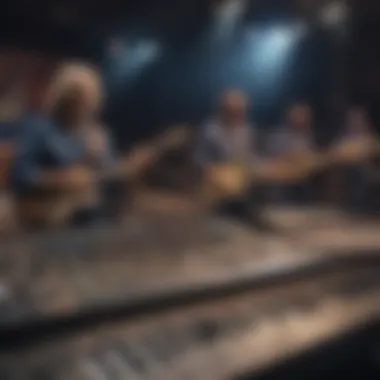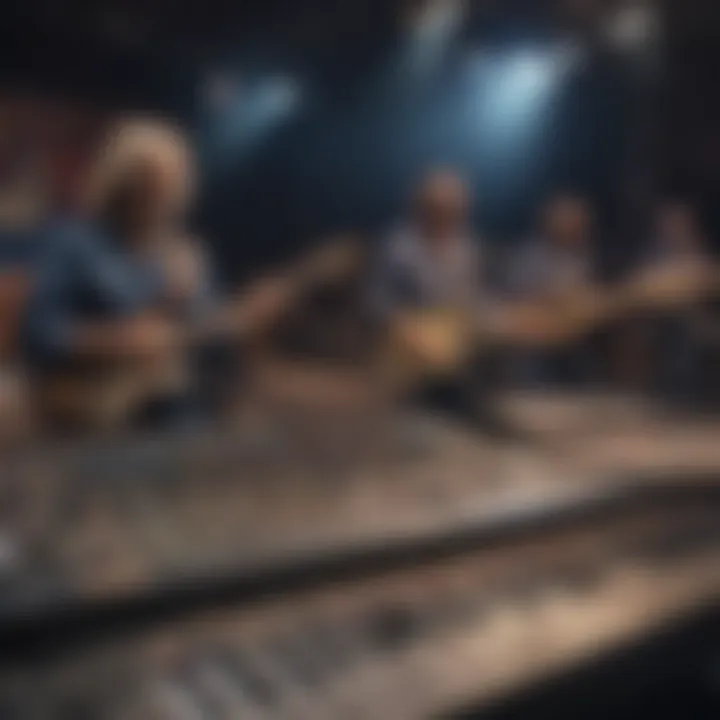The Grateful Dead: A Journey Beyond Music


Intro
The Grateful Dead stand as a unique phenomenon in American music history. Their narrative stretches beyond mere notes and albums; it encompasses a cultural revolution. This article will delve into the band's journey, highlighting their distinctive contributions, influences, and the lasting impact they left on music and society.
Artist Profile
Biography and Background
Formed in 1965 in San Francisco, The Grateful Dead emerged from the vibrant counterculture of the time. The band's initial lineup included Jerry Garcia, Bob Weir, Phil Lesh, and Mickey Hart. Each member brought their distinct musical voice, contributing to their eclectic sound. The Dead's approach to performance was revolutionary. They emphasized live improvisation, which created a unique relationship with their audience. Their concerts often became long, surreal experiences, blurring the line between performer and listener.
A hallmark of their style was the blending of various genres, such as rock, folk, blues, and jazz, all framed within their improvisational ethos. This genre-bending ability allowed them to craft an expansive discography, which served as a rich landscape for their numerous live performances.
Major Influences and Inspirations
The Grateful Dead drew inspiration from many sources. Among these, the folk revival of the early 1960s played a significant role. Artists like Bob Dylan and bands such as The Band shaped their lyrical content and musical style. The jazz scene, particularly artists like Miles Davis and John Coltrane, influenced their improvisational techniques. This blend of influences created a musical tapestry that was both innovative and deeply rooted in American traditions.
Additionally, the social upheavals of the 1960s, including the civil rights movement and anti-war protests, served as a backdrop to their music. The band's lyrics reflected these societal themes, echoing the concerns of a generation yearning for change.
"The meaning of music is not only found in the notes played but also in the spaces between them, a principle The Grateful Dead embraced fully."
Song Analysis
Theme and Lyrics Breakdown
The Grateful Dead's songs often explore complex themes. Love, loss, and adventure are interwoven throughout their extensive catalog. Tracks like "Ripple" and "Friend of the Devil" showcase lyrical depth, painting vivid scenes while conveying profound emotions.
The band utilized storytelling, inviting listeners into intricate narratives. Their ability to capture fleeting moments and emotions resonates with many. This lyricism creates a connection that extends beyond the music itself.
Instrumentation and Composition
Instrumentally, The Grateful Dead excelled. Their performances showcased remarkable musicianship. Garcia's guitar solos often take center stage, weaving melodic phrases that can evoke strong feelings. The dual drumming of Bill Kreutzmann and Mickey Hart gave the band a distinct rhythmic foundation.
The interplay between instruments is noteworthy. Harmonies created by Weir and Lesh's bass lines contribute to the texture of their sound. Each performance varies, making live recordings a treasure trove for fans.
Preface to The Grateful Dead
The Grateful Dead is not merely a band; it represents a phenomenon in American music history. Their unique approach to music, intertwining multiple genres and philosophies, establishes an important foundation for understanding their cultural significance. This section delves into the early days of the band, which set the tone for their innovative future.
Overview of the Band's Formation
The formation of The Grateful Dead in 1965 can be seen as a convergence of various artistic influences. Initially, Jerry Garcia, Bob Weir, Phil Lesh, and others came together in the San Francisco area, each bringing distinct musical backgrounds. Their unique synergy allowed them to explore sounds that defied traditional categorization. San Francisco, during the 1960s, was a hub for counterculture, and this environment greatly influenced the band's ethos.
The early rehearsals took place in a garage, reflecting a raw and unpolished approach. Unlike many bands that prioritized a polished sound, The Grateful Dead embraced spontaneity and experimentation from the outset. This willingness to step outside conventional boundaries laid the groundwork for their future innovations.
Key Members and Their Contributions
Key figures in The Grateful Dead each contributed significantly to their identity. Jerry Garcia, as the lead guitarist and primary songwriter, infused the band with a distinctive melodic sensibility. His improvisational skills became synonymous with the band's live performances. Bob Weir, the rhythm guitarist, provided a crucial counterbalance, often layering complex chords that deepened their sound.
Phil Lesh, on bass, brought a classical perception to his playing, integrating complex lines that created an unusual depth. Other members, such as Ron "Pigpen" McKernan and later keyboardists like Keith Godchaux and Brent Mydland, added different textures, making the band's sound richly varied. Together, these contributions formed a collective that not only pushed musical boundaries but also established a semblance of community.
Defining Moments in Early Years
In the nascent years, The Grateful Dead experienced moments that punctuated their journey. Their first album, The Grateful Dead, released in 1967, contained experimental tracks that showcased their diverse genres, from rock to folk. It was during live shows that the band truly shone, where improvisation played a defining role. The Fillmore's concerts, for example, became legendary, establishing a reputation for marathon performances that engaged the audience intimately.
The blending of genres and the improvisational spirit can be highlighted in their rendition of songs like "Dark Star," which transformed into a long, exploratory journey during performances. This approach attracted a passionate following, often referred to as "Deadheads," who sought not merely music but an encompassing experience.
The early trajectory of The Grateful Dead illustrated how a group could transform music into a communal experience. Their initial years set a precedent that intertwined music with a wider cultural movement, which would continue to evolve as the band matured.
Musical Evolution
The musical evolution of The Grateful Dead serves as a rich tapestry that reflects their innovative nature and profound impact on American music. This aspect is crucial because it demonstrates how the band not only embraced various genres but also created a unique sound that influenced countless artists. It invites listeners and scholars alike to appreciate the intricate layers of creativity that stemmed from their work in various styles. The significance of this evolution lies in its ability to resonate with diverse audiences and adapt over time, informing both their musical direction and cultural relevance.
Genre Blending: Rock, Folk, and Jazz
The Grateful Dead's approach to genre blending was revolutionary. They skillfully intertwined rock, folk, and jazz elements to create a sound that was distinctly their own.
- Rock provided a strong foundation, characterized by electric guitars and driving rhythms.
- Folk infused narratives and acoustic elements, often drawing on themes of American life and experiences.
- Jazz contributed improvisational techniques, adding a level of spontaneity and creativity.
This fusion allowed them to appeal to a wide audience, from casual listeners to dedicated music aficionados. Their songs frequently transitioned from structured verses into free-form improvisations, often extending beyond typical song lengths. This quality of unpredictability became part of their trademark, allowing bands and musicians to experiment and evolve. This genre blending has continued to inspire various music scenes, as artists strive to emulate the Dead's innovative spirit.
Live Performance Dynamics
The live performances of The Grateful Dead are legendary in their own right. They transformed concert experiences into communal gatherings rather than mere musical events. The band's ability to engage the audience shaped their musical evolution significantly. Each concert was unique, with setlists varying from night to night, ensuring that no two shows were alike. Fans often traveled from city to city to attend consecutive performances, seeking the organic energy that was ignited during these shows.
- Improvisation played an essential role in their live acts. Musicians often explored extended jams, allowing each member to showcase talent and creativity.
- Energy Exchange with the audience was palpable. This connection fostered a spirit of collaboration and excitement that extended beyond the stage.
- Accessibility to fans through recorded live shows further added to their enduring popularity, as listeners could relive the experience.
This dynamic emphasis on live performance fundamentally changed how concerts were perceived by audiences, influenced future jam bands, and contributed distinctly to their legacy.
Studio Albums and Their Impact
The studio albums of The Grateful Dead are significant reflections of their musical journey. Each album showcases different facets of their sound and has made a lasting impact on music production and composition. Their debut album, The Grateful Dead, set the stage for their unique style, offering listeners a glimpse of their eclectic sound.
- American Beauty and Workingman’s Dead showcased an acoustic direction that appealed to the folk-rock movement.
- Live/Dead served as a benchmark for live albums, capturing the essence of their improvisational style in a studio setting.
- These albums often incorporated lyrical themes that resonated deeply with cultural and existential questions, enriching their discography.
The influence of these studio works has been observed in many artists who followed, emphasizing authenticity, depth, and the importance of artistic exploration. The Grateful Dead not only shaped their genre but also set a precedent for future musicians to blend sounds and consciousness within recorded music.
Cultural Influences


The cultural influences surrounding The Grateful Dead play a significant role in their identity as a band. Understanding these influences offers insights into their music, ethos, and the broader movements they were part of. The art and culture of a specific time period often shape musical tones and lyrics, and for The Grateful Dead, this interplay was crucial to their evolution. The band's trajectory coincided with pivotal historical moments, which enriched their sound and shaped their audience.
Counterculture Movement
The Grateful Dead emerged during the 1960s, a period marked by social upheaval and a powerful counterculture movement. This era sought to challenge the status quo, advocating for peace, love, and personal freedom. The Dead's music intertwined with these themes, often reflecting the ideals of their audience. The Summer of Love in 1967 set the stage for the band's widespread popularity. Their live concerts served as communal spaces, drawing in individuals searching for connection and an alternative to mainstream society.
As a representative of this counterculture, The Grateful Dead became synonymous with the celebration of individuality and exploration of consciousness. Their songs not only entertained but also encouraged listeners to contemplate deeper meanings and community values. This period in history profoundly shaped the band, creating a lasting bond with fans who embraced their distinct ethos.
Influence of the West Coast Sound
The West Coast music scene in the 1960s nurtured a diverse array of musical styles, blending rock, folk, jazz, and blues. This eclectic mix found a harmonious home within The Grateful Dead’s sound. Inspired by local artists and venues, they experimented with various genres, creating a unique auditory experience. The Bay Area in California became a hub for artistic expression, allowing The Grateful Dead to flourish.
The band’s earlier works, such as their debut album The Grateful Dead, showcased this blend distinctly. It highlighted the rich textures of folk harmonies intertwined with rock's energy and improvisational elements drawn from jazz. Furthermore, their sound evolved alongside the emerging psychedelic rock, which contributed to their experimental approach and ongoing evolution throughout their career.
Interactions with Other Artists
A notable aspect of The Grateful Dead’s influence comes from their collaborations and relationships with a variety of artists. Interacting with musicians such as Jefferson Airplane, Crosby, Stills, Nash & Young, and individual performers like Bob Dylan introduced new styles and concepts into their music. These interactions were not limited to performances; they often resulted in a cross-pollination of ideas that enriched their creativity.
Collaboration provided platforms for unity among artists of that era. The Dead were known for their inclusive nature, often inviting other musicians to join them on stage, creating spontaneous musical moments. This approach allowed for the integration of diverse influences into their performances, enhancing their appeal across different musical genres.
"The Grateful Dead’s legacy is interwoven with the spirit of collaboration and community that defines the era of their emergence."
In summary, the cultural influences on The Grateful Dead are multifaceted and deeply rooted in the complexities of their time. This section reveals the band's engagement with the counterculture movement, the impact of the West Coast sound, and their collaborative spirit with other artists. These elements contribute to a broader understanding of their music and its enduring significance.
Philosophy and Lyrics
The philosophy and lyrics of The Grateful Dead are vital components that shape their identity and influence. Beyond the music, their lyrical narratives resonate deeply with themes of life, love, and the human experience. These elements are essential for understanding their impact on fans and the broader music landscape. The band’s commitment to conveying a philosophical outlook enhances their artistry, allowing listeners to connect on multiple levels.
Themes of Community and Connection
One of the most compelling themes in The Grateful Dead's lyrics is the sense of community. The band cultivated a devoted following, often referred to as "Deadheads." The lyrics often reflect the importance of togetherness and shared experiences. Songs like "Ripple" and "Friend of the Devil" evoke imagery of bonds formed through music and togetherness. The music became a catalyst for connections among fans. Live performances are events where these principles thrive, creating a sense of belonging.
This theme extends beyond individual songs. The band’s touring lifestyle fostered unique communities. Concerts transformed into gatherings of like-minded people seeking both musical enjoyment and personal connection. This communal aspect solidified the band's place in the cultural fabric of America.
Exploring Existential Questions
Another prominent aspect of The Grateful Dead's lyrics is their exploration of existential themes. The lyrics delve into the complexities of existence, time, and consciousness. Songs such as "Dark Star" and "The Other One" invite listeners to contemplate deeper questions about life and the universe. The lyrics often blur the lines between reality and the metaphysical, prompting introspection in those who engage with the music.
Moreover, the layered meanings in their lyrics convey the band's philosophical perspectives. They touch upon life’s uncertainties and ephemeral nature. This resonates with an audience that often grapples with similar questions. Engaging with their music often leads to personal reflection, making the listening experience profound.
The Role of Improvisation
Improvisation plays a critical role in the music of The Grateful Dead. Their live performances often feature spontaneous compositions, a hallmark of their style. This approach not only showcases their musical prowess but also creates an atmosphere of unpredictability and discovery. Each performance offers a unique experience, shaped by the collective energy of both the band and its audience.


Improvisation reflects the philosophy of living in the moment. It aligns with the broader themes of their lyrics that often embrace change and the fluidity of life. This practice has influenced many musicians who seek to infuse spontaneity into their performances. By prioritizing improvisation, The Grateful Dead emphasizes the emotional and transformative power of live music.
"The true nature of music is that it is always changing, just like life itself."
In summary, the philosophy and lyrics of The Grateful Dead are intricately woven together. They inspire a sense of community while provoking thought about existence. The band’s improvisational spirit aligns seamlessly with their thematic content, offering listeners a rich and varied experience that goes beyond simple entertainment.
Legacy of The Grateful Dead
The legacy of The Grateful Dead is not just a story of music; it is a complex narrative woven into the fabric of American culture. Their influence extends beyond sound, impacting countless artists and shaping entire genres while altering how live music is experienced. The band's dedication to improvisation and their non-conventional approach to performances set them apart, creating an experience that feels monumental.
Influence on Subsequent Generations
Numerous musicians have cited The Grateful Dead as a significant inspiration. Their musical style, characterized by a blend of rock, jazz, and folk, has become a model for those willing to experiment. Bands like Phish and Wilco draw from the improvisational spirit of The Grateful Dead, carrying their legacy forward. The band's fans, referred to as "Deadheads," have also forged a community that transcends generations. They have hosted large gatherings that celebrate the band's music, creating a culture that values creativity and connection.
Tribute Bands and Continuing Fan Culture
Tribute bands have been key in keeping the spirit of The Grateful Dead alive. Groups like Dark Star Orchestra deliver authentic renditions of the band's extensive catalog while maintaining the ethereal live experience. The fan culture surrounding these tribute events showcases the deep appreciation for The Grateful Dead's music. Beyond just music, it is about shared experiences and communal bonds. Through social media platforms like Reddit and Facebook, fans connect and keep the music alive, continually sharing their love for the songs and the memories they hold.
The Ongoing Relevance of Their Message
The messages within The Grateful Dead's lyrics resonate with modern themes of peace, love, and acceptance. These messages are timeless, appealing to the collective consciousness in times of turmoil. In a world often filled with division, their call for unity inspires. The idea of "being grateful" and celebrating life’s moments continues to attract new listeners. Consequently, The Grateful Dead's philosophy remains relevant, inviting reflection in a rapidly changing society.
"The Grateful Dead's impact on culture is immeasurable. They taught us that music is about connection, not just performance."
Their commitment to social issues and their unique ability to blend genres create an enduring discourse, ensuring their place in music history.
End
The conclusion of this article serves as a crucial element in distilling the complex narrative of The Grateful Dead. It encapsulates the critical points discussed, emphasizing their significant impact in the realm of music and culture. This section is not merely an afterthought; rather, it synthesizes the threads of their musical evolution, cultural interactions, and philosophical insights. Readers gain insight into why the band holds a special place in the hearts of many, demonstrating their reach beyond just entertainment.
Throughout the article, we have explored various aspects of The Grateful Dead's journey, including their genre-blending styles, profound lyrics, and communal philosophy. Their ability to merge rock, folk, and jazz set them apart, creating a unique sound that generations of fans resonate with. Understanding these elements deepens one's appreciation of their music and highlights their relevance in today’s complex society.
Final Reflections on Their Impact
Reflecting on the impact of The Grateful Dead reveals a band that was innovative yet deeply rooted in tradition. Their contributions to music extended beyond mere notes and rhythms; they shaped a cultural movement and a way of life for countless individuals. The philosophy of improvisation is central to their identity, leading to live performances that often felt like rituals of community and self-expression.
The Dead's influence permeated various music genres and inspired a multitude of artists. Many musicians cite them as a significant inspiration, not solely for their sound but for their approach to music and performance. The band taught its followers to embrace spontaneity and creativity, aspects that continue to inspire new generations.
The Grateful Dead challenged us to explore music as a strategy for connection and artistic expression rather than mere commercial success.
Moreover, the expansive Community that formed around the band — the fans known as "Deadheads" — fostered a unique culture. This loyalty and communal experience contributed to the band’s lasting legacy.
Looking Ahead: Future of Their Legacy
Looking to the future, the legacy of The Grateful Dead remains vibrant and dynamic. Their music continues to attract new listeners while their message of community, acceptance, and exploration remains relevant in contemporary discussions. As the world evolves, so too does the interpretation of their music and philosophy.
The legacy of The Grateful Dead is preserved not just through their recorded work but also through countless tribute bands that keep their spirit alive. These bands recreate the live experiences that defined The Grateful Dead, allowing new audiences to engage with their music. With streaming platforms aiding this resurgence, the accessibility of their catalog ensures that new fans discover their music daily.
In an age where connection can feel scattered, the ideals of The Grateful Dead about community and shared experiences continue to resonate deeply. Their message encourages listeners to find joy in togetherness and the moment — ideas that, if embraced, could greatly benefit society as a whole.
Ultimately, the story of The Grateful Dead remains a poignant reflection of musical evolution, cultural exchange, and enduring impact. As we look ahead, we can anticipate the continued exploration of their music for insights and inspiration, reaffirming that some legacies are destined to transcend time.







